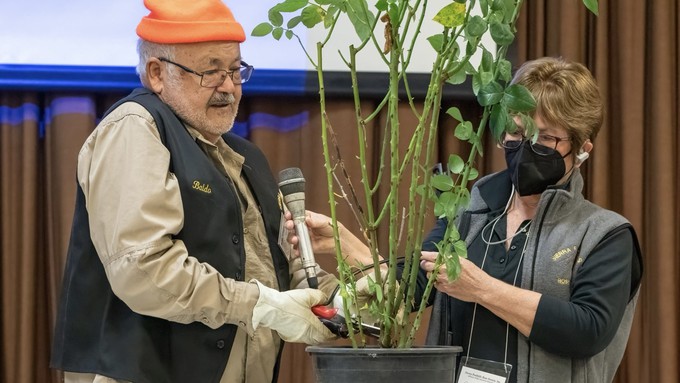
Learn how at free rose pruning workshop

Master rosarians at work: Baldo Villegas prunes a rose bush at a previous workshop. Charlotte Owendyk holds the microphone so he can narrate his work. Courtesy Sierra Foothills Rose Society
It’s time to sharpen your rose pruning skills!
Get some expert advice and hands-on training at the Sierra Foothills Rose Society’s annual Winter Rose Care Workshop at the Orangevale Grange Auditorium, 5807 Walnut Ave., Orangevale.
Set for 9 a.m. Jan. 11, this free event covers all aspects of rose pruning, then wraps up with lunch – a chili cookoff!
No advance registration necessary and the public is welcome. Bring gloves and bypass pruners.
The workshop features master rosarians Baldo Villegas, Linda Knowles and Charlotte Owendyk – each a nationally recognized, award-winning rose grower.
“Practice under the watchful eye of experienced rosarians who prune hundreds of their own roses,” say the organizers. “When you leave, you will confidently prune your roses!”
Make that “thousands” of roses; Baldo grows more than 3,000 bushes at his Orangevale home. With that many roses, he knows how to get pruning done pronto.
Highlight of this workshop is always Baldo’s demonstration of his “Three-Minute Pruning Method.” He’ll show how to prune a full-size hybrid tea in three minutes – and often less – by looking at the plant from the base up. By identifying the canes to keep first, the job becomes much simpler.
Instructors also will share advice on pruning tools as well as how to control pests and diseases in the garden (an important part of why we prune roses every year).
The morning-long session wraps up with a chili cookoff at 12:30 p.m. Participants vote for the best chili while also having an opportunity to get advice from the society’s rose experts one on one.
For more on Sierra Foothills Rose Society: www.sierrafoothillsrosesociety.org.
Comments
0 comments have been posted.Sacramento Digs Gardening to your inbox.
Food in My Back Yard Series
May 6: Maintain soil moisture with mulch for garden success
April 29: What's (already) wrong with my tomato plants?
April 22: Should you stock up on fertilizer? (Yes!)
April 15: Grow culinary herbs in containers
April 8: When to plant summer vegetables
April 1: Don't be fooled by these garden myths
March 25: Fertilizer tips: How to 'feed' your vegetables for healthy growth
March 18: Time to give vegetable seedlings some more space
March 11: Ways to win the fight against weeds
March 4: Potatoes from the garden
Feb. 25: Plant a fruit tree now -- for later
Feb. 18: How to squeeze more food into less space
Feb. 11: When to plant? Consider staggering your transplants
Feb. 4: Starting in seed starting
Sites We Like
Garden Checklist for week of May 11
Make the most of the lower temperatures early in the week. We’ll be back in the 80s by Thursday.
* Plant, plant, plant! It’s prime planting season in the Sacramento area. Time to set out those tomato transplants along with peppers and eggplants. Pinch off any flowers on new transplants to make them concentrate on establishing roots instead of setting premature fruit.
* Direct-seed melons, cucumbers, summer squash, corn, radishes, pumpkins and annual herbs such as basil.
* Harvest cabbage, lettuce, peas and green onions.
* In the flower garden, direct-seed sunflowers, cosmos, salvia, zinnias, marigolds, celosia and asters. (You also can transplant seedlings for many of the same flowers.)
* Plant dahlia tubers.
* Transplant petunias, marigolds and perennial flowers such as astilbe, columbine, coneflowers, coreopsis, dahlias, rudbeckia and verbena.
* Keep an eye out for slugs, snails, earwigs and aphids that want to dine on tender new growth.
* Feed summer bloomers with a balanced fertilizer.
* For continued bloom, cut off spent flowers on roses as well as other flowering plants.
* Add mulch to the garden to maintain moisture. Mulch also cuts down on weeds. But don’t let it mound around the stems or trunks of trees or shrubs. Leave about a 6-inch-to-1-foot circle to avoid crown rot or other problems.
* Remember to weed! Pull those nasties before they set seed.
* Water early in the day and keep seedlings evenly moist.